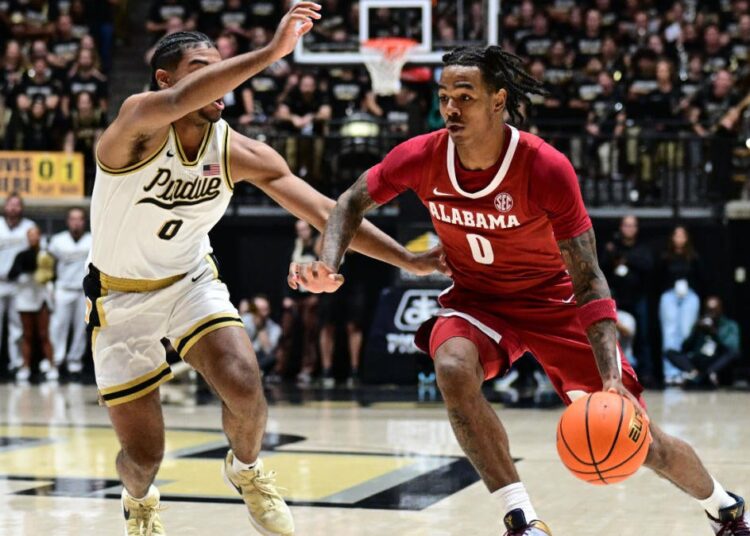College basketball is in full swing with some of the top in-season tournaments and multiteam events right around the corner. Let’s dive into this week’s edition of Ten Things!
1. The subtle shake of Alabama’s Labaron Philon
You’re here for basketball but can we start with a football analogy? Philon, Alabama’s star freshman guard, sure reminds me of one of those explosive running backs who can set up a would-be tackler by running straight at him before putting his foot in the ground and exploding in a different direction. Shades of former Tide running back Jahmyr Gibbs, perhaps?
Philon’s herky-jerky, change of direction was on full display on the road at Purdue in front of a raucous Mackey Arena. Alabama lost but the freshman shined with 18 points, five rebounds, four assists and multiple missed tackles (somehow, didn’t see that on the stat sheet).
He dusted multiple Purdue defenders with his stop-start, stutter-step move.
Alabama’s Mark Sears is still the best player on the team. When healthy, South Florida transfer Chris Youngblood might be No. 2, but Philon is hurtling toward the top of Alabama’s food chain. He has been Nate Oats’ best two-way player so far.
2. Arizona State’s Jayden Quaintance’s shows defensive upside
Arizona State’s Quaintance is the youngest player in college basketball, but he should be on the shortlist for Defensive Player of the Year. The 17-year-old freshman has shown every ounce of his God-given tools. Quaintance is averaging 3.4 blocks per game and ranks 15th nationally with a sky-high, 13.8 block percentage.
Quaintance douses so many fires for Arizona State at the rim, but it’s his mobility, wingspan and court-coverage on the perimeter that’s so impressive. He’s flying from the middle of the floor and blocking shots that he has no business even sniffing.
Oh, and because he’s so young, we should get a second year of his brilliance before he heads to the NBA. It’s great for the sport.
3. St. John’s RJ Luis breaks out some bully-ball
Basketball has a ton of finesse in it, but sometimes, you just have to hit a dude.
That was fully displayed in St. John’s 85-71 win over New Mexico. Luis, a chiseled wing, just bulldozed through the Lobos time and time again for big-boy buckets.
There wasn’t much nuance or flare to Luis’ game. If you were in his way, he was going through you. New Mexico forward Mustapha Amzil had a good game, finishing with 16 points and four 3-pointers, but he took a beating on the other end.
Rick Pitino smelled blood in the water in the second half and just rode Luis over and over again on his way to a 21-point, 11-rebound, seven-assist gem.
For all the offseason chatter about all the new studs that St. John’s acquired in free agency, it’s a returner who has been Pitino’s best player so far.
4. Which teams are winning the math?
A major point of emphasis for some of the top NBA defenses, like the Minnesota Timberwolves and Boston Celtics, has been limiting 3-point attempts.
Early-season stats are noisy, but here are the college basketball teams that rank in the top-50 nationally in the percentage of 3-pointers taken and top-50 nationally in the fewest percentage of 3-pointers allowed.
Basically: these teams take a bunch of 3-pointers and don’t give up many.
- Illinois (second in offensive 3-point rate, 32nd in defensive 3-point rate)
- DePaul (10th in offensive 3-point rate, 16th in defensive 3-point rate)
- North Florida (29th in offensive 3-point rate, 21st in defensive 3-point rate)
- Drake (30th in offensive 3-point rate, eighth in defensive 3-point rate)
- UConn (50th in offensive 3-point rate, 22nd in defensive 3-point rate)
- Kennesaw State (43rd in offensive 3-point rate, 11th in defensive 3-point rate)
- Fordham (44th in offensive 3-point rate, 18th in defensive 3-point rate)
- Utah Tech (45th in offensive 3-point rate, 43rd in defensive 3-point rate)
5. Purdue’s Myles Colvin refuses to get screened
Colvin’s defense was a big reason why Purdue knocked off Alabama 87-78 Friday. Alabama’s Sears finished with 15 points on 5-for-15 shooting, and he didn’t make a single shot when Colvin was the closest defender.
How?
Insert screen navigation.
Positional size is all well and good defensively … until you get labeled on every single screen.
Colvin, a slick, 6-5, 205-pound guard, has terrific size on the perimeter, but his ability to get skinny and stay attached to Sears was impressive. He didn’t let Cliff Omoruyi’s bulldozing screens scrape him off Alabama’s star guard.
Alabama’s offense thrives when it can get two defenders guarding one man, but Colvin’s pestering defense allowed the rest of Purdue’s defense to stay mostly attached.
Colvin was rewarded on the game’s last possession when he stuffed Sears’ layup attempt. The sophomore guard then did his version of the “Lambeau Leap” and soared into the Paint Crew to celebrate.
After 20 hard minutes of dodging various would-be screeners to keep up with a fast All-American, Colvin deserved all of it.
6. Northwestern’s Nick Martinelli’s has unguardable runner
Martinelli, who had little high-major interest as a recruit and was once committed to Elon, has turned into one heck of a player for Chris Collins. The Northwestern junior is up to eighth nationally in scoring, averaging a whopping 24.6 points.
He owns the most automatic runner in college basketball.
Martinelli has scored 17 points this season, via runners, which is tied for No. 1 in the sport alongside Western Kentucky’s Dom McHenry. He’s shooting 61.5% on runners this year. Only Purdue’s Trey Kaufman-Renn (63.6%) is better.
Martinelli is comfortable in the area of the floor that so many people are trying to avoid. That awkward nine-foot floater in the middle of the paint is the money zone for Martinelli. He can uncork it whenever he wants. Defenders know it’s coming and still can’t stop it.
7. Pitt’s Damian Dunn turns off-target passes into assists
Damian Dunn spent a year in Kelvin Sampson’s doghouse at Houston, so he returned to his old Pennsylvania stomping grounds. He’s wasted no time getting hot for Jeff Capel’s Pitt club. Through five games, Dunn is averaging 15.2 points while shooting over 52% from downtown.
An on-target pass makes a good shooter a great shooter. What does it mean when you get a bad pass but still make the shot? Whatever it is, that’s what Dunn is doing.
He eviscerated West Virginia for 23 points on 7-12 shooting, including a pair of tough 3-pointers after scooping the ball basically off the ground.
Louisiana Tech is a haven for high-major transfers to rediscover themselves. Kaden Cooper played sparingly at Oklahoma last year, but he has come alive for one of Conference USA’s best teams. Cooper has put together some insane defensive sequences in his first four games for Talvin Hester’s 4-0 Bulldogs.
Granted, two of Louisiana Tech’s games have come against non-Division I opponents, but regardless, Cooper has been a stocks (steals and blocks) machine.
Cooper has 15 stocks in the first four games, including a five-steal, one-block showing against UT Arlington.
Some of Cooper’s defensive tape is jaw-dropping and ridiculously fun. He makes stealing inbounds passes look way too easy.
The souped-up 6-5 wing is a major name to watch and Louisiana Tech has all the ingredients to be a team that can make major noise in the NCAA Tournament. Stud center Daniel Batcho and standout guard Amaree Abram, a former Ole Miss and Georgia Tech product, are the headliners for La Tech, but Cooper is developing into a lockdown wing with major upside.
Could he follow the Isaiah Crawford model?
9. UNC’s Drake Powell evokes Michael Jordan memories
Drake Powell’s offensive numbers (4.7 points, 0.7 assists per game) will not blow you away, but North Carolina’s five-star freshman is already one of the best defenders in the sport. The 6-6 wing had one of the most disrespectful blocks the college game has seen this season.
Hubert Davis’ postgame interview was gold.
“Last time I can remember that was (Michael Jordan) doing that when we played together with the Wizards,” Davis said. “We were playing the Chicago Bulls, and they were going in for a layup on me. They would have easily scored, because there’s no way I was going to do anything. And Michael, at 40, came from nowhere and grabbed it with two hands.”
10. A late-game clock blunder
While the rest of the world was watching an incredible NFL back-and-forth showdown between Joe Burrow and Justin Herbert on Sunday, old Pac-12 foes USC and California were tangling in what is now a nonconference game between new members of the Big Ten and ACC.
Cal emerged with a 71-66 victory with a little help from the shot-clock operator at USC’s Galen Center.
Check out this sequence, and then we’ll go back through it piece by piece.
Did you catch what happened? If not, here’s the skinny:
Clock — 29.1 seconds: With USC trailing 68-66, Cal’s Joshua Ola-Joseph snares an offensive rebound with 29.1 seconds left.
What happened: The rule is the shot clock should’ve been reset to 20 seconds, not 30 seconds, after an offensive rebound. There would have been a nine-second difference between the shot clock and game clock. USC by two points, so it could’ve defended for one more possession without fouling to try and get the ball back with time to tie or win the game. However, USC’s shot-clock operator incorrectly turns the clock off for five precious seconds.
Clock — 23.9 seconds — Terrance Williams turns his head to the bench where Eric Musselman is directing him to foul because the shot clock is off and Musselman does not want to let Cal hold the ball, run out the clock and win the game.
What happened: This is when the shot-clock operator realizes the mistake and flips the shot clock to 20 seconds with 23.9 seconds left in regulation. The difference between turning on the shot clock of 3.9 seconds and 9.1 seconds is just 5.2 seconds, but that is an eternity in late-game situations and Musselman had already directed Williams to foul because the shot clock read zero.
Clock — 21.6 seconds: USC fouls Cal star Andrej Stojakovic to stop the clock.
What happened: USC assistant coach Michael Musselman realizes the clock issue first, but the Trojans can’t do anything about it now. The Trojans already fouled. Eric Musselman gets alerted, understands what happened and the frustration boils over when he turns to the clock operators and yells, ‘Why did you guys turn the shot clock off?’ Stojakovic calmly makes the free throws to give the Bears a 70-66 lead on the way to a 71-66 victory, handing USC its first loss of the year.
Read the full article here



























Discussion about this post